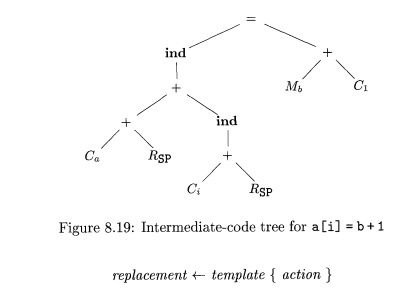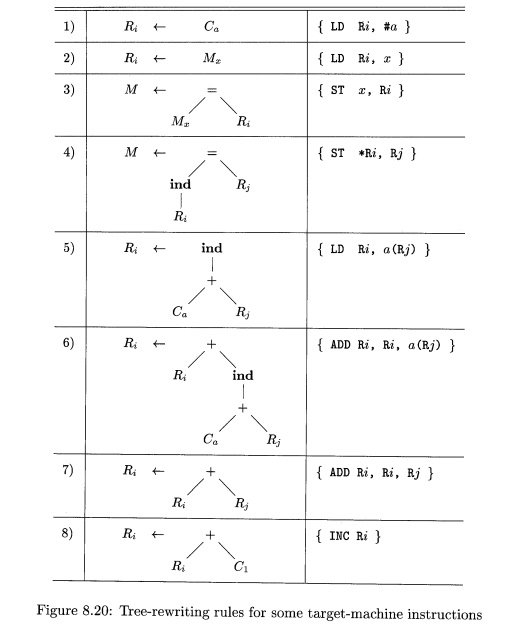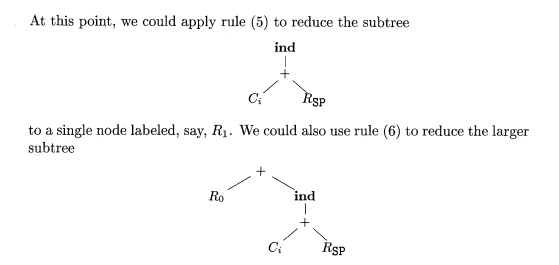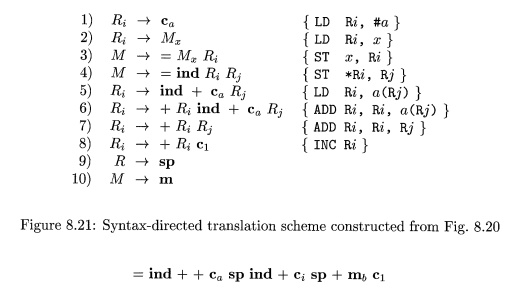Chapter: Compilers : Principles, Techniques, & Tools : Code Generation
Instruction Selection by Tree Rewriting
Instruction Selection by Tree
Rewriting
1 Tree-Translation Schemes
2 Code Generation by Tiling an
Input Tree
3 Pattern Matching by Parsing
4 Routines for Semantic Checking
5 General Tree Matching
6 Exercises for Section 8.9
Instruction selection can be a
large combinatorial task, especially on machines that are rich in addressing
modes, such as CISC machines, or on machines with special-purpose instructions,
say, for signal processing. Even if we assume that the order of evaluation is
given and that registers are allocated by a separate mechanism, instruction
selection — the problem of selecting target-language instructions to implement
the operators in the intermediate representation — remains a large
combinatorial task.
In this section, we treat
instruction selection as a tree-rewriting problem. Tree representations of target
instructions have been used effectively in code-generator generators, which
automatically construct the instruction-selection phase of a code generator
from a high-level specification of the target machine. Better code might be
obtained for some machines by using DAG's rather than trees, but DAG matching
is more complex than tree matching.
1. Tree-Translation Schemes
Throughout this section, the input to the code-generation process will
be a sequence of trees at the semantic level of the target machine. The trees
are what we might get after inserting run-time addresses into the intermediate
representation, as described in Section 8.3. In addition, the leaves of the
trees contain information about the storage types of their labels.
Example 8 . 1 8 : Figure
8.19 contains a tree
for the assignment statement a [ i ] = b + l , where
the array a is stored on the run-time stack and the variable b is a global in
memory location The run-time addresses of locals a and i are given as constant
offsets Ca and Ci from SP, the
register containing the pointer to the beginning of the current activation
record.
The assignment to a [ i ] is an
indirect assignment in which the r-value
of the location for a [ i ] is set to the r-value of the expression b+ 1. The addresses of array a and variable i are
given by adding the values of the constant Ca
and Ci, respectively, to the contents of register SP. We simplify
array-address calcu-lations by assuming that all values are one-byte
characters. (Some instruction sets make special provisions for multiplications
by constants, such as 2, 4, and 8, during address calculations.)
In the tree, the ind operator treats its argument as a memory address. As the left
child of an assignment operator, the ind
node gives the location into which the r-value on the right side of the
assignment operator is to be stored. If an argument of a + or ind operator is a memory location or a
register, then the contents of that memory location or register are taken as
the value. The leaves in the tree are labeled with attributes; a subscript
indicates the value of the attribute. •
The target code is generated by applying a sequence of tree-rewriting
rules to reduce the input tree to a single node. Each tree-rewriting rule has
the form

where replacement
is a single node, template is a tree,
and action is a code fragment, as in
a syntax-directed translation scheme.
A set of tree-rewriting rules is called a tree-translation scheme.
Each tree-rewriting rule
represents the translation of a portion of the tree given by the template. The
translation consists of a possibly empty sequence of machine instructions that
is emitted by the action associated with the template. The leaves of the
template are attributes with subscripts, as in the input tree. Sometimes,
certain restrictions apply to the values of the subscripts in the templates;
these restrictions are specified as semantic predicates that must be satisfied
before the template is said to match. For example, a predicate might specify
that the value of a constant fall in a certain range.
A tree-translation scheme is a
convenient way to represent the instruction-selection phase of a code
generator. As an example of a tree-rewriting rule, consider the rule for the
register-to-register add instruction:

This rule is used as follows. If
the input tree contains a subtree that matches this tree template, that is, a
subtree whose root is labeled by the operator + and whose left and right
children are quantities in registers i
and j, then we can replace that
subtree by a single node labeled Ri
and emit the instruction ADD
Ri,Ri,Rj as
output. We call this replacement a
tiling of the
subtree. More than one template may match a subtree at a given time; we shall
describe shortly some mechanisms for deciding which rule to apply in cases of
conflict.
E x a m p l e 8 . 1 9 : Figure 8.20 contains
tree-rewriting rules for a few instructions of our target machine. These rules
will be used in a running example throughout this section. The first two rules
correspond to load instructions, the next two to store instructions, and the
remainder to indexed loads and additions. Note that rule (8) requires the value
of the constant to be 1. This condition would be specified by a semantic
predicate. •
2. Code Generation by Tiling an
Input Tree
A tree-translation scheme works
as follows. Given an input tree, the templates in the tree-rewriting rules are
applied to tile its subtrees. If a template matches, the matching subtree in
the input tree is replaced with the replacement node of the rule and the action
associated with the rule is done. If the action contains a sequence of machine
instructions, the instructions are emitted. This process is repeated until the
tree is reduced to a single node, or until no more templates match. The
sequence of machine instructions generated as the input tree is reduced to a
single node constitutes the output of the tree-translation scheme on the given
input tree.
The process of specifying a code
generator becomes similar to that of us-ing a syntax-directed translation
scheme to specify a translator. We write a tree-translation scheme to describe
the instruction set of a target rnachine. In practice, we would like to find a
scheme that causes a minimal-cost instruction sequence to be generated for each
input tree. Several tools are available to help build a code generator
automatically from a tree-translation scheme.
Example 8 . 2 0 :
Let us use the tree-translation scheme in Fig. 8.20 to generate code for
the input tree in Fig. 8.19. Suppose that the first rule is applied to load the
constant Ca into register RO:

The label of the leftmost leaf then changes from
Ca to R0 and the instruction LD RO, #a is generated.
The seventh rule now matches the leftmost subtree with root labeled +:

Using this rule, we rewrite this subtree as a single node labeled RQ and generate the instruction ADD RO, RO, SP. Now the
tree looks like



to a single node labeled Ro
and generate the instruction ADD
RO, RO, i(SP). Assuming that it is more
efficient to use a single instruction to compute the larger subtree rather than
the smaller one, we choose rule (6) to get

In the right subtree, rule (2)
applies to the leaf It generates
an instruction to load b into register Rl, say.
Now, using rule (8) we can match the subtree

This remaining tree is matched by
rule (4), which reduces the tree to a single node and generates the instruction
ST *R0,
Rl. We generate the following code
sequence:
LD RO,
#a
ADD RO, RO, SP
ADD RO, RO,
i(SP)
LD Rl,
b
INC Rl
ST *R0,
Rl
in the process of reducing the tree to a single node. •
In order to implement the
tree-reduction process in Example 8.18, we must address some issues related to
tree-pattern matching:
How is tree-pattern matching to be done? The efficiency of the
code-generation process (at compile time) depends on the efficiency of the
tree-matching algorithm.
• What do we do if more than one
template matches at a given time? The efficiency of the generated code (at run
time) may depend on the order in which templates are matched, since different
match sequences will in general lead to different target-machine code
sequences, some more efficient than others.
If no template matches, then the
code-generation process blocks. At the other extreme, we need to guard against
the possibility of a single node being rewritten indefinitely, generating an
infinite sequence of register move instruc-tions or an infinite sequence of
loads and stores.
To prevent blocking, we assume
that each operator in the intermediate code can be implemented by one or more
target-machine instructions. We further assume that there are enough registers
to compute each tree node by itself. Then, no matter how the tree matching
proceeds, the remaining tree can always be translated into target-machine
instructions.
3. Pattern Matching by Parsing
Before considering general tree
matching, we consider a specialized approach that uses an LR parser to do the
pattern matching. The input tree can be treated as a string by using its prefix
representation. For example, the prefix representation for the tree in Fig.
8.19 is

The tree-translation scheme can
be converted into a syntax-directed trans-lation scheme by replacing the
tree-rewriting rules with the productions of a context-free grammar in which
the right sides are prefix representations of the instruction templates.
Example 8 . 2 1 : The
syntax-directed translation scheme in
Fig. 8.21 is based on the tree-translation scheme in
Fig. 8.20.
The nonterminals of the underlying grammar are R and M.
The terminal m represents a
specific memory location, such as the location for the global variable b in
Example 8.18. The production M m in Rule (10) can be thought of as matching M
with m prior to using one of the templates involving M. Similarly, we introduce
a terminal sp for register SP and add the production R S P . Finally, terminal
c represents constants.
Using these terminals, the string
for the input tree in Fig. 8.19 is

From the productions of the
translation scheme we build an LR parser using one of the LR-parser
construction techniques of Chapter 4. The target code is generated by emitting
the machine instruction corresponding to each reduction.
A code-generation grammar is
usually highly ambiguous, and some care needs to be given to how the
parsing-action conflicts are resolved when the parser is constructed. In the
absence of cost information, a general rule is to favor larger reductions over
smaller ones. This means that in a reduce-reduce conflict, the
longer reduction is favored; in a
shift-reduce conflict, the
shift move is chosen. This "maximal munch" approach causes a larger number of operations
to be performed with a single machine instruction. There
are some benefits to
using LR parsing in code generation. First, the parsing method is efficient and
well understood, so reliable and efficient code generators can be produced
using the algorithms described in Chapter 4. Second, it is relatively easy to
retarget the resulting code generator; a code selector for a new machine can be
constructed by writing a grammar to describe the instructions of the new
machine. Third, the quality of the code generated can be made efficient by
adding special-case productions to take advantage of machine idioms.
However, there are some challenges as well. A
left-to-right order of evalua-tion is fixed by the parsing method. Also, for
some machines with large numbers of addressing modes, the machine-description
grammar and resulting parser can become inordinately large. As a consequence,
specialized techniques are neces-sary to encode and process the
machine-description grammars. We must also be careful that the resulting parser
does not block (has no next move) while parsing an expression tree, either
because the grammar does not handle some operator patterns or because the
parser has made the wrong resolution of some parsing-action conflict. We must
also make sure the parser does not get into an infinite loop of reductions of
productions with single symbols on the right side. The looping problem can be
solved using a state-splitting technique at the time the parser tables are
generated.
4. Routines for Semantic Checking
In a code-generation translation scheme, the same
attributes appear as in an input tree, but often with restrictions on what
values the subscripts can have. For example, a machine instruction may require
that an attribute value fall in a certain range or that the values of two
attributes be related.
These restrictions on attribute
values can be specified as predicates that are invoked before a reduction is
made. In fact, the general use of semantic actions and predicates can provide
greater flexibility and ease of description than a purely grammatical
specification of a code generator. Generic templates can be used to represent
classes of instructions and the semantic actions can then be used to pick
instructions for specific cases. For example, two forms of the addition
instruction can be represented with one template:

Parsing-action conflicts can be
resolved by disambiguating predicates that can allow different selection
strategies to be used in different contexts. A smaller description of a target
machine is possible because certain aspects of the machine architecture, such
as addressing modes, can be factored into the attributes. The complication in
this approach is that it may become difficult to verify the accuracy of the
translation scheme as a faithful description of the target machine, although
this problem is shared to some degree by all code generators.
5. General Tree Matching
The LR-parsing approach to
pattern matching based on prefix representations favors the left operand of a
binary operator. In a prefix representation op E1 E2, the
limited-lookahead LR parsing decisions must be made on the basis of some prefix
of Ei, since E1 can be arbitrarily long. Thus, pattern matching can miss nuances
of the target-instruction set that are due to right operands.
Instead prefix representation, we
could use a postfix representation. But, then an LR-parsing approach to pattern
matching would favor the right oper-and.
For a hand-written code
generator, we can use tree templates, as in Fig. 8.20, as a guide and write an
ad-hoc matcher. For example, if the root of the input tree is labeled ind, then
the only pattern that could match is for rule (5); otherwise, if the root is
labeled +, then the patterns that could match are for rules (6-8).
For a code-generator generator,
we need a general tree-matching algorithm. An efficient top-down algorithm can
be developed by extending the string-pattern-matching techniques of Chapter 3.
The idea is to represent each tem-plate as a set of strings, where a string
corresponds to a path from the root to a leaf in the template. We treat all
operands equally by including the position number of a child, from left to
right, in the strings.
Example 8 . 2 2 : In building the
set of strings for an instruction set, we shall drop the subscripts, since
pattern matching is based on the attributes alone, not on their values.
The templates in Fig. 8.22 have
the following set of strings from the root to a leaf:

The string C represents the template with C
at the root. The string +1R
represents the + and its left operand R
in the two templates that have + at the root.

Using sets of strings as in Example 8.22, a
tree-pattern matcher can be constructed by using techniques for efficiently
matching multiple strings in parallel.
In practice, the tree-rewriting process can be
implemented by running the tree-pattern matcher during a depth-first traversal
of the input tree and per-forming the reductions as the nodes are visited for
the last time.
Instruction costs can be taken into account by
associating with each tree-rewriting rule the cost of the sequence of machine
instructions generated if that rule is applied. In Section 8.11, we discuss a
dynamic programming algorithm that can be used in conjunction with tree-pattern
matching.
By running the dynamic programming algorithm
concurrently, we can select an optimal sequence of matches using the cost
information associated with each rule. We may need to defer deciding upon a
match until the cost of all alternatives is known. Using this approach, a
small, efficient code generator can be
constructed quickly from a tree-rewriting scheme. Moreover, the dynamic
programming algorithm frees the code-generator designer from having to resolve
conflicting matches or decide upon an order for the evaluation.
6. Exercises for Section 8.9
Exercise
8.9.1: Construct syntax trees for each
of the following statements
assuming all nonconstant operands are in memory
locations:
a ) x = a * b + c
* d ;
b) x [ i ] = y [ j ] * z [ k ] ;
c) x = x +
1;
Use the tree-rewriting scheme in Fig. 8.20 to
generate code for each statement.
Exercise
8.9.2 : Repeat Exercise 8.9.1
above using the syntax-directed trans-lation scheme in Fig. 8.21 in
place of the tree-rewriting scheme.
Exercise 8.9.3: Extend
the tree-rewriting scheme in Fig.
8.20 to apply to while- st
at ement s.
Exercise
8.9.4: How would you extend tree
rewriting to apply to DAG's?
Related Topics